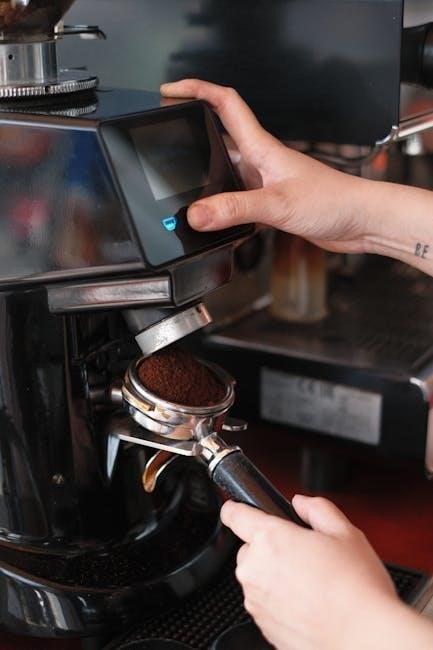
Welcome to the Cuisinart Espresso Machine Manual, your comprehensive guide to mastering espresso brewing at home. This manual provides detailed instructions, troubleshooting tips, and maintenance advice to ensure optimal performance and delicious results.
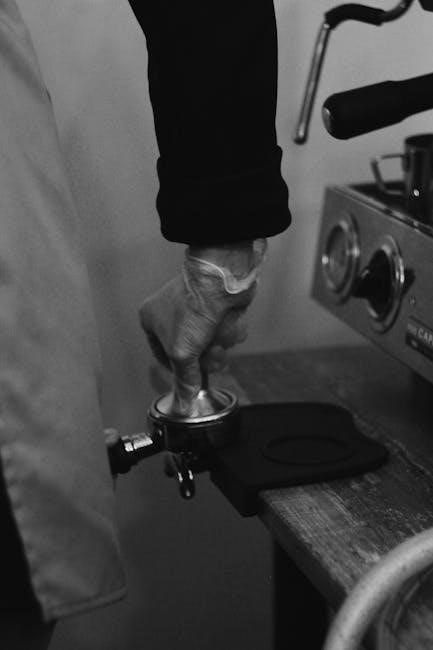
Overview of the Cuisinart Espresso Machine
The Cuisinart Espresso Machine is a versatile and user-friendly appliance designed for coffee enthusiasts. It offers a range of features, including multiple beverage options, built-in grinders, and customizable settings. With models like the EM-100C and EM-25, users can enjoy espresso, cappuccinos, and lattes with ease. These machines are known for their durability, sleek designs, and compatibility with various coffee beans and grind sizes. Whether you’re a novice or an experienced barista, Cuisinart espresso machines provide the tools to craft high-quality coffee drinks at home, making them a great addition to any kitchen.
Importance of Reading the Manual
Reading the Cuisinart Espresso Machine manual is essential for ensuring safe and efficient operation. It provides critical information on setup, usage, and maintenance, helping you avoid potential damages or hazards. The manual also offers troubleshooting tips and guidance on achieving the best flavor from your machine. By understanding the machine’s features and proper care, you can extend its lifespan and enjoy consistent, high-quality espresso. Additionally, the manual includes recipes and customization options, empowering you to explore various coffee creations with confidence. Taking the time to review it thoroughly will enhance your overall experience and satisfaction with the product.
Components of the Cuisinart Espresso Machine
The Cuisinart Espresso Machine features a water reservoir, control panel, drip tray, portafilter, and frothing pitcher. These components work together to deliver precise brewing and frothing capabilities for perfect espresso.
Key Parts and Accessories
The Cuisinart Espresso Machine includes essential parts like the water reservoir, control panel, drip tray, and portafilter. Accessories such as a frothing pitcher and coffee scoop are also provided. The water reservoir is located at the top, making it easy to fill and clean. The control panel features buttons for power, espresso, and steam functions. The drip tray catches excess water and coffee grounds, while the portafilter holds the coffee grounds in place. Additional accessories like a tamper ensure optimal espresso preparation. These components and accessories work together to enhance your brewing experience and simplify cleanup. Proper use of each part is crucial for achieving the best results.
Understanding the Control Panel
The control panel of the Cuisinart Espresso Machine is user-friendly, featuring buttons for power, espresso, and steam. It includes a menu for customizing settings like cup size and temperature. The panel also has a steam wand control for frothing milk and a display for monitoring brewing progress. Indicators alert you when the water reservoir is low or when the machine needs descaling. Understanding each button and light ensures you can operate the machine efficiently and customize your espresso experience to your liking. Familiarizing yourself with the control panel is key to making the most of your espresso machine’s capabilities.
Setting Up Your Cuisinart Espresso Machine
Unbox and position the machine on a flat surface. Ensure all parts are included and the drip tray is securely placed. Fill the water reservoir with fresh, cold water, plug in the machine, and turn it on. Allow it to heat up properly before brewing your first shot of espresso.
Unboxing and Initial Preparation
Begin by carefully unboxing your Cuisinart Espresso Machine and verifying all components, including the machine, portafilter, coffee scoop, and user manual. Place the machine on a stable, flat surface and ensure the drip tray is securely positioned. Rinse the water reservoir thoroughly before filling it with fresh, cold water. Plug in the machine and turn it on to allow it to heat up properly. Review the safety guidelines and ensure all parts are correctly aligned. This initial setup ensures a smooth and safe brewing experience, helping you make the most of your espresso machine.
Filling the Water Reservoir
To fill the water reservoir, locate it on the top of the machine. Lift the lid and pour fresh, cold water or filtered water into the reservoir until it reaches the recommended level. Avoid overfilling to prevent spills. Replace the lid securely and ensure the reservoir is properly aligned. Once filled, plug in the machine and turn it on. The machine will begin heating the water, indicated by the heating light. Allow it to heat up completely before brewing to ensure optimal temperature and flavor. Proper water preparation is essential for achieving the best espresso results. Always use clean, fresh water for brewing.
Plugging in and Turning On the Machine
Before first use, ensure the machine is placed on a stable, flat surface. Plug the power cord into a nearby electrical outlet. Press the power button to turn on the machine. The red heating light will illuminate, indicating the machine is preheating. Allow the machine to heat up completely until the light turns off, signaling it is ready for use. Ensure the water reservoir is filled before turning on the machine. Always check for any error lights or unusual noises during startup. Proper power-on procedures ensure safe and efficient operation of your Cuisinart Espresso Machine.
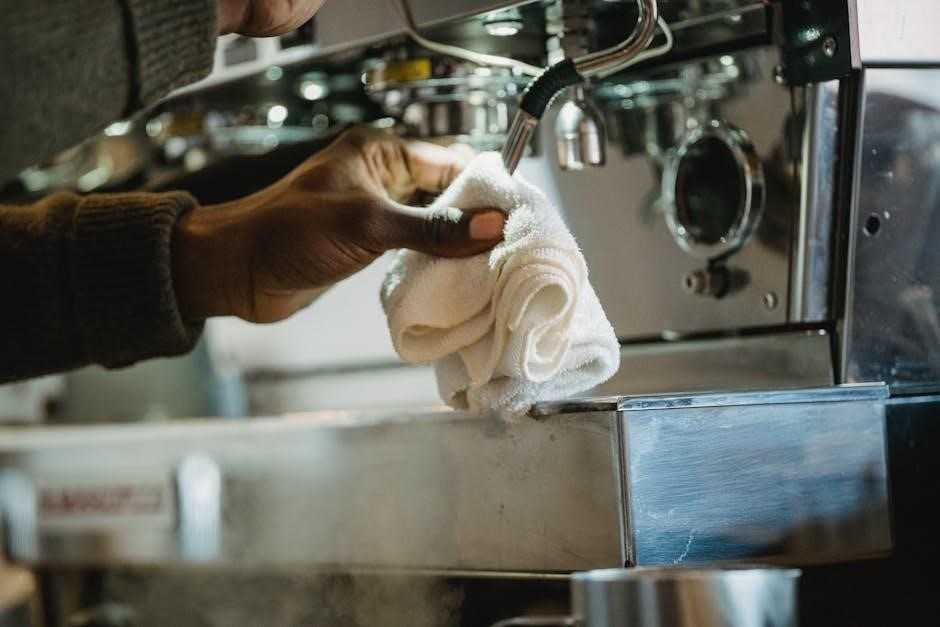
Brewing Guide for Beginners
Welcome to the Cuisinart Espresso Machine Brewing Guide. This section will walk you through the essential steps to brew perfect espresso, from preparation to serving. Start by filling the water reservoir, ensuring the drip tray is in place. Plug in the machine, turn it on, and wait for the heating light to turn off, indicating it’s ready. Insert the portafilter with ground coffee, place a cup under the spout, and press the brew button. Monitor the shot glass and enjoy your espresso. The machine will stop automatically for safety.
Step-by-Step Brewing Process
Start by filling the water reservoir with fresh, cold water. Ensure the drip tray and grate are securely in place. Plug in the machine and turn it on, waiting for the heating light to turn off, indicating it’s ready. Grind your coffee beans to the desired consistency and tamp the grounds firmly into the portafilter. Attach the portafilter to the machine and place a demitasse cup under the spout. Press the brew button to begin the extraction process. The machine will automatically stop after brewing the perfect shot of espresso. Your espresso is now ready to enjoy or use as a base for other coffee drinks.
Choosing the Right Coffee Beans
Selecting high-quality coffee beans is essential for achieving the best flavor with your Cuisinart Espresso Machine. Opt for freshly roasted, aromatic beans, as stale coffee can negatively impact taste. Arabica beans are recommended for their nuanced flavor, while Robusta adds a bold, rich note. Medium to dark roasts are ideal for espresso, providing a balanced and intense profile. Grind the beans just before brewing to ensure maximum freshness and optimal extraction. Proper storage in an airtight container, away from light and heat, preserves flavor and aroma. Freshly roasted beans within two weeks of opening yield the best results for a perfect espresso experience.
Adjusting Grind Size for Optimal Flavor
Proper grind size is crucial for achieving the perfect espresso. A fine to medium grind is ideal for most espresso machines, as it allows for the right water flow and extraction. If the grind is too fine, it can cause channeling or low pressure, leading to weak espresso. Conversely, a grind that’s too coarse may result in under-extracted shots. Experiment with your grinder to find the optimal setting. Use freshly roasted beans for the best flavor and adjust the grind size based on the beans’ origin and roast level. A burr grinder is recommended for consistent results.

Advanced Brewing Techniques
Explore expert methods to elevate your espresso game, including customizing shots, mastering milk frothing, and troubleshooting for consistent, professional-quality results at home.
Customizing Your Espresso Shot
Customizing your espresso shot allows you to tailor the flavor to your preferences. Adjust the grind size of your coffee beans for optimal extraction, as a finer grind increases richness while a coarser grind reduces bitterness. Experiment with the tamping pressure to ensure even extraction. You can also modify the brewing time to achieve your desired strength. For a stronger shot, extend the brewing time, and for a lighter one, shorten it. Additionally, explore different coffee bean origins and roast levels to diversify your espresso experience. Refer to your manual for specific guidance on adjusting these settings.
Creating Cappuccinos and Lattes
To create cappuccinos and lattes, start by brewing a rich espresso shot using your Cuisinart machine. For a cappuccino, combine 1-2 ounces of espresso with 3-4 ounces of steamed milk and a layer of frothed milk on top. For a latte, use a higher milk-to-espresso ratio, typically 5-6 ounces of steamed milk with a thin layer of froth. Use the machine’s frothing pitcher to heat and froth milk to your desired consistency. Experiment with milk types and temperatures for the perfect texture. Refer to your manual for specific frothing settings and tips to achieve professional-quality results at home.
Exploring Milk Frothing Options
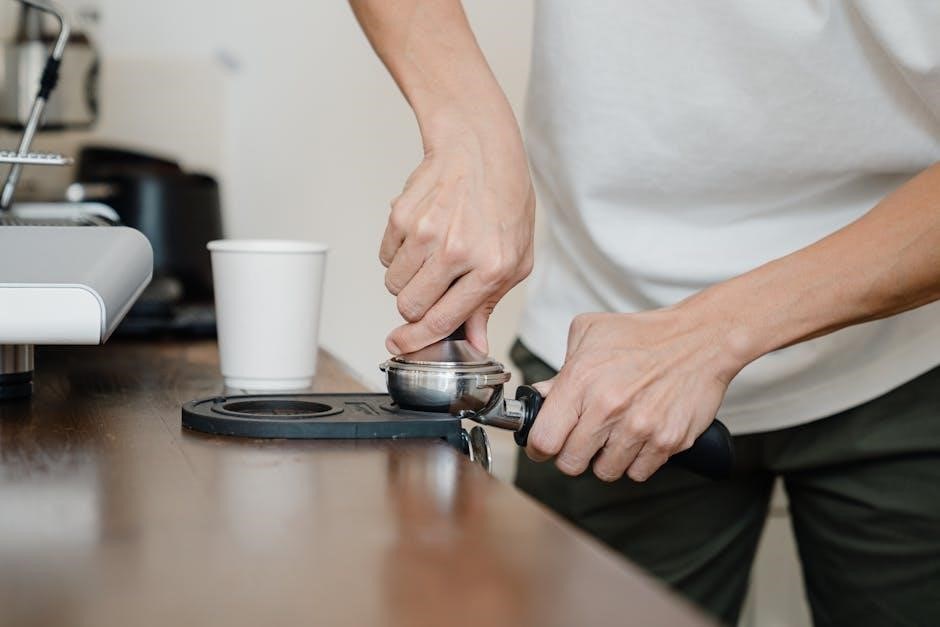
Creating cappuccinos and lattes with your Cuisinart espresso machine involves a few key steps. Start by brewing a rich espresso shot. For a cappuccino, combine 1-2 ounces of espresso with 3-4 ounces of steamed milk and a layer of frothed milk on top. For a latte, use a higher milk-to-espresso ratio, typically 5-6 ounces of steamed milk with a thin layer of froth. Use the machine’s frothing pitcher to heat and froth milk to your desired consistency. Experiment with milk types and temperatures for the perfect texture. Refer to your manual for specific frothing settings and tips to achieve professional-quality results at home.

Maintenance and Cleaning
Regular cleaning, descaling, and maintenance ensure optimal performance. Clean the machine after use, empty the drip tray, and check for scale buildup. Use filtered water.
Daily Cleaning Routine
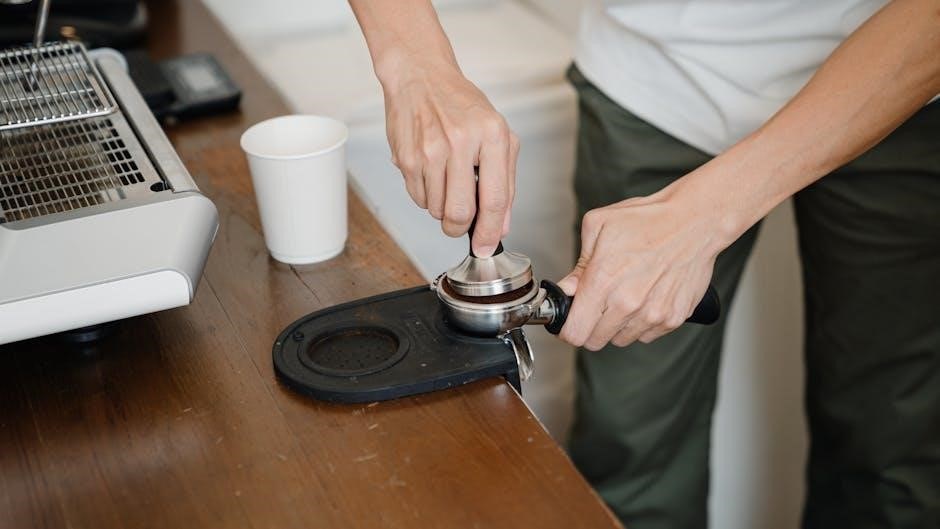
Daily Cleaning Routine
Regular cleaning is essential for maintaining your Cuisinart Espresso Machine’s performance and hygiene. After each use, wipe the machine’s exterior with a damp cloth and clean the drip tray and grate. Remove and rinse the portafilter, and empty the used coffee grounds. For the water reservoir, refill with fresh water daily and avoid leaving stale water overnight. Descale the machine periodically to prevent mineral buildup. Turn off the machine and allow it to cool before cleaning internal parts. This routine ensures optimal functionality and prevents bacterial growth, keeping your espresso tasting its best.
Descaling the Machine
Descaling your Cuisinart Espresso Machine is crucial to remove mineral buildup and prevent damage from hard water. Use a Cuisinart-approved descaling solution or a compatible alternative. Follow the steps in your manual: pour the solution into the water reservoir, run it through the machine without coffee grounds, and repeat until clean water flows. Perform this process every 1-3 months, depending on usage and water hardness. Regular descaling ensures optimal performance, prevents clogs, and extends the machine’s lifespan. Always rinse thoroughly after descaling to remove any residue and maintain the quality of your espresso.
Regular Maintenance Checks
Regular maintenance ensures your Cuisinart Espresso Machine performs optimally and lasts longer. Check for wear and tear on seals, gaskets, and hoses, replacing them if necessary. Ensure all connections are tight to prevent leaks. Empty and clean the drip tray regularly to avoid overflow. Lubricate moving parts as recommended to maintain smooth operation. Clean the brew head and portafilter after each use to prevent old coffee oils from affecting flavor. These simple checks help maintain performance, prevent issues, and ensure consistent espresso quality. Schedule these inspections every few months for best results.
Troubleshooting Common Issues
Troubleshooting common issues with your Cuisinart Espresso Machine ensures optimal performance. Identify and resolve problems like low pressure, weak espresso, or the machine not turning on with this guide.
Identifying and Solving Brewing Problems
Common brewing issues with the Cuisinart Espresso Machine include low pressure, weak espresso, or inconsistent flavor. Check water levels in the reservoir and ensure the machine is preheated. If espresso is weak, adjust the grind size or tamping pressure. For low pressure, clean or descale the machine to remove mineral buildup. Refer to the troubleshooting guide for specific error lights or unusual noises. Regular maintenance, like cleaning the brew head and ensuring proper alignment of the portafilter, can prevent many issues. Consult the manual or contact Cuisinart support for persistent problems to ensure optimal performance and flavor.
Machine Not Turning On
If your Cuisinart Espresso Machine fails to turn on, first ensure it is properly plugged into a working electrical outlet. Check the power cord for any damage or kinks. Verify that the water reservoir is filled, as some models require water to operate. If the issue persists, reset the machine by unplugging it, waiting 30 seconds, and plugging it back in. Consult the troubleshooting section of the manual for specific error lights or codes. If none of these steps resolve the issue, contact Cuisinart customer support for further assistance or repair options.
Low Pressure or Weak Espresso
If your Cuisinart Espresso Machine produces low pressure or weak espresso, check the grind size of your coffee beans. A grind that’s too coarse can prevent proper extraction. Ensure the portafilter is tightly secured and the coffee grounds are evenly tamped. Scale buildup in the machine can also reduce water flow, so descale regularly. If the issue persists, inspect the pump for wear or blockages. Refer to the manual for descaling instructions and maintenance tips to restore optimal pressure and flavor to your espresso shots.
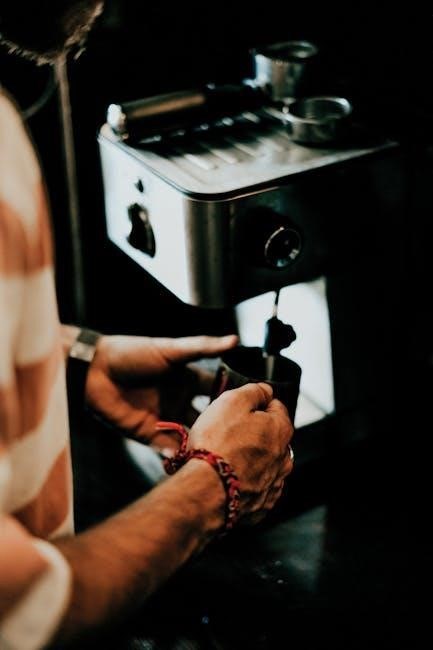
Safety Precautions
Always handle hot parts with care, keep children away, and avoid touching sharp edges. Ensure the machine is placed on a stable surface and unplugged when not in use. Follow electrical safety guidelines and avoid overheating the machine. Regularly inspect cords and components for damage. Never submerge the machine in water or expose it to extreme temperatures. Adhere to these precautions to ensure safe operation and longevity of your Cuisinart Espresso Machine.
General Safety Guidelines
Always prioritize safety when using your Cuisinart Espresso Machine. Handle hot components with care, and keep children away from the machine. Place it on a stable, heat-resistant surface and ensure proper ventilation. Avoid overloading electrical outlets, and never leave the machine unattended during operation. Regularly inspect cords and components for damage. Keep the machine clean and dry to prevent electrical hazards. Follow all instructions carefully, and avoid using damaged or worn-out parts. By adhering to these guidelines, you can ensure safe and efficient use of your espresso machine while preventing potential risks.
Handling Hot Parts Safely
When using your Cuisinart Espresso Machine, always handle hot parts with caution. Use oven mitts or towels to touch the portafilter, brew head, or other heated components. Never expose the machine to water while it is hot, as this can cause damage or electrical hazards. Keep children away from hot surfaces and steam wands. Allow the machine to cool slightly before cleaning or maintenance. Avoid touching any metal parts immediately after brewing, as they may be extremely hot. Always ensure the machine is on a stable, heat-resistant surface to prevent accidental burns or damage.
Electrical Safety Tips
Always plug your Cuisinart Espresso Machine into a dedicated electrical outlet to avoid overloading circuits. Never use damaged cords or loose plugs, as this can cause electrical hazards. Keep the machine away from water sources to prevent shocks or malfunctions. Avoid submerging any electrical parts in water, and ensure the machine is placed on a stable, dry surface. Never leave the machine unattended while it is in operation. Disconnect the power cord when cleaning or performing maintenance to ensure safety. Regularly inspect cords and plugs for wear and tear, replacing them if necessary. Follow these guidelines to ensure safe and reliable operation.
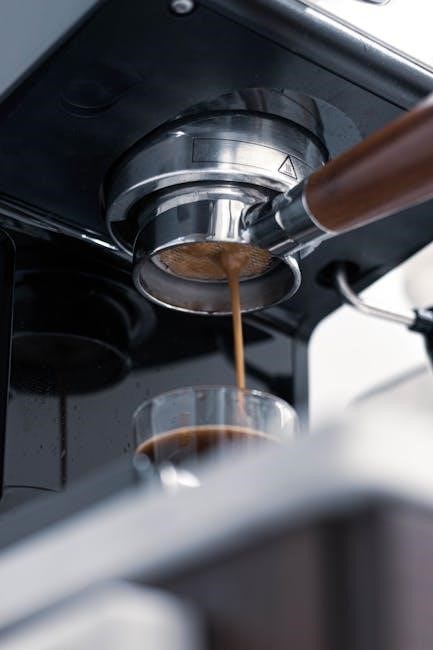
Additional Resources
Visit the official Cuisinart website for downloadable manuals, troubleshooting guides, and customer support contact information. Explore accessories and maintenance tips to enhance your espresso experience.
Downloading the Manual Online
Downloading the Cuisinart Espresso Machine manual is straightforward. Visit the official Cuisinart website or platforms like ManualsLib and ManualsOnline. Search for your specific model, such as the EM-100 or EM-200, and download the PDF. These resources provide free access to user manuals, ensuring you always have a digital copy. This is especially useful for troubleshooting or replacing a lost manual. Make sure to verify the model number for accuracy. Once downloaded, you can easily navigate through the guide, accessing brewing tips, maintenance instructions, and warranty information anytime. This convenient option keeps your manual readily available for future reference.
Cuisinart Customer Support Contact
For assistance with your Cuisinart Espresso Machine, contact their customer support team. Visit the official Cuisinart website and navigate to the “Support” section for contact details. You can reach them via phone at 1-800-726-0190, Monday through Friday, 9 AM to 5 PM EST. Additionally, submit inquiries through their online contact form or email at consumer.service@cuisinart.com. For quick help, utilize the live chat feature on their website. Their support team is ready to address questions, troubleshooting, or warranty concerns. Ensure to have your model number handy for efficient assistance. Visit Cuisinart Support for more information.

Recommended Accessories and Parts
To enhance your espresso-making experience, consider these recommended accessories for your Cuisinart Espresso Machine. A Cuisinart Water Filter ensures pure water for better-tasting espresso. Cleaning tablets are essential for regular maintenance, preventing mineral buildup. A steam wand brush helps keep the milk frothing system clean. Additionally, a high-quality coffee grinder is crucial for freshly grinding beans. For replacement parts, such as the portafilter or seals, visit the Cuisinart website or authorized retailers. These accessories and parts are designed to maintain your machine’s performance and extend its lifespan. Visit Cuisinart.com for genuine products.